Introduction
In the realm of .NET development, managing file tracking efficiently is essential for maintaining a streamlined workflow. The .NET Gitignore file plays a pivotal role in this process, allowing developers to specify which files should be excluded from version control. By effectively utilizing this file, teams can avoid unnecessary clutter in their repositories, ensuring that only relevant files are committed.
This article delves into the purpose of a .NET Gitignore file, offers a step-by-step guide for its creation, highlights common pitfalls to avoid, and presents best practices for ongoing maintenance. With these insights, developers can enhance their productivity and foster a cleaner, more organized codebase.
Understanding the Purpose of a .NET Gitignore File
In .NET development, a Gitignore document is crucial for excluding items that should not be tracked by Git. This includes compiled binaries, temporary data, and user-specific configurations that can clutter your repository and lead to unnecessary conflicts.
By specifying what to disregard, developers can preserve a clean and efficient codebase, ensuring that only pertinent items are committed. Common entries in a development ignore list include:
bin/- Compiled binariesobj/- Intermediate object files*.user- User-specific settings*.suo- Solution user options*.vs/- Visual Studio settings
Understanding the purpose of this document helps streamline the development process and prevents potential issues down the line.
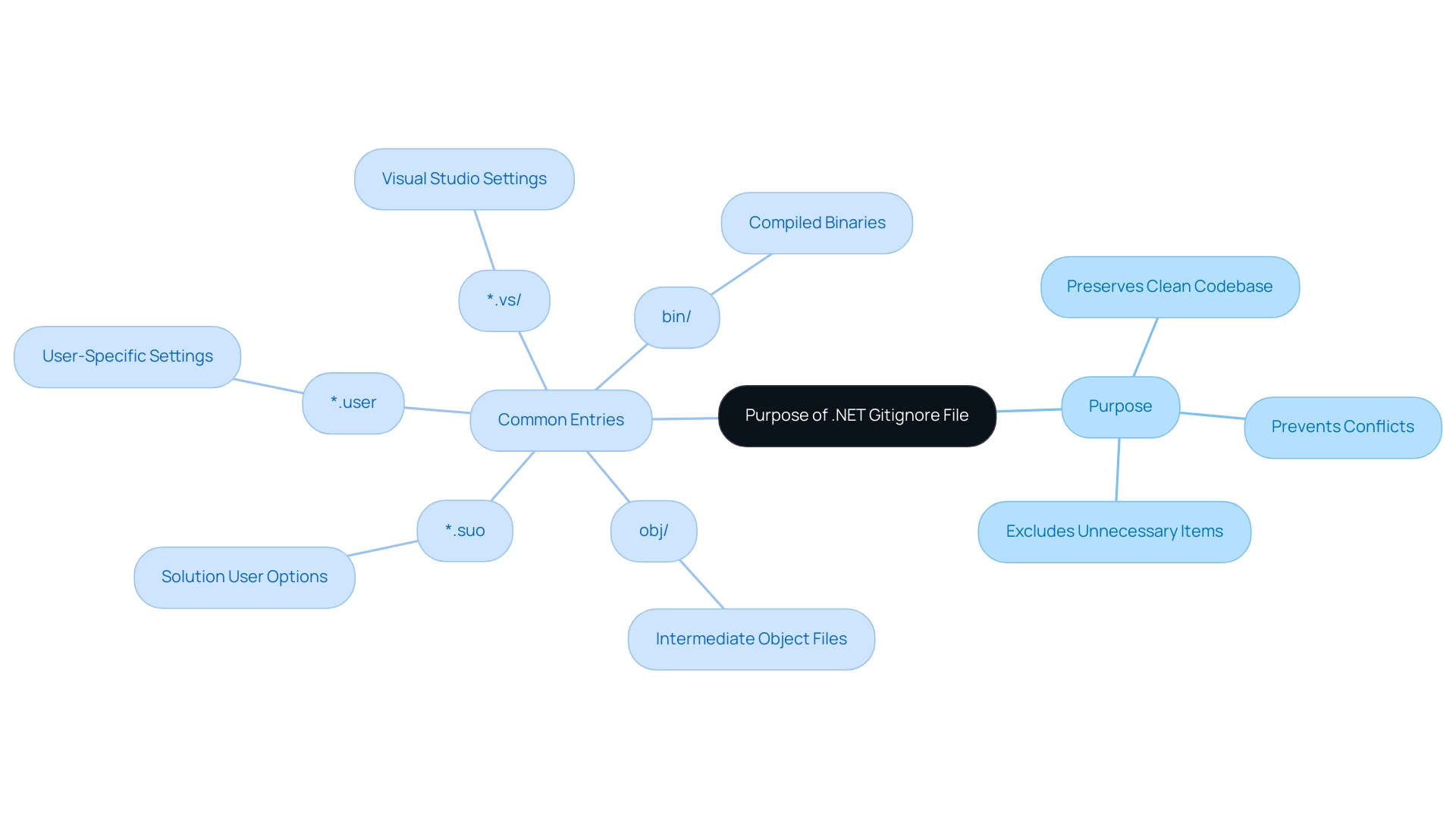
Step-by-Step Guide to Creating Your .NET Gitignore File
Establishing a dotnet gitignore list is a simple procedure. Follow these steps:
-
Navigate to Your Project Directory: Open your terminal or command prompt and navigate to the root directory of your .NET project.
-
Create the Gitignore File: Use the following command to create a new .gitignore file:
touch .gitignoreAlternatively, you can create the file using a text editor.
-
Open the Dotnet Gitignore Document: Open the newly created
.gitignorein your preferred text editor. -
Define Ignored Files and Directories: Add the necessary entries to your
dotnet gitignorefile. For a typical .NET project, consider including the following lines:bin/ obj/ *.user *.suo *.vs/These entries will ensure that Git ignores compiled binaries, object files, and user-specific settings.
-
Save the Changes: After adding the necessary entries, save the
dotnet gitignorefile. -
Verify the Gitignore Functionality: Run the following command to check which files are being ignored:
git check-ignore -v *This will display the ignored files based on your Gitignore configuration.
By following these steps, you can create an effective .NET Gitignore file that enhances your version control process and maintains a clean codebase.
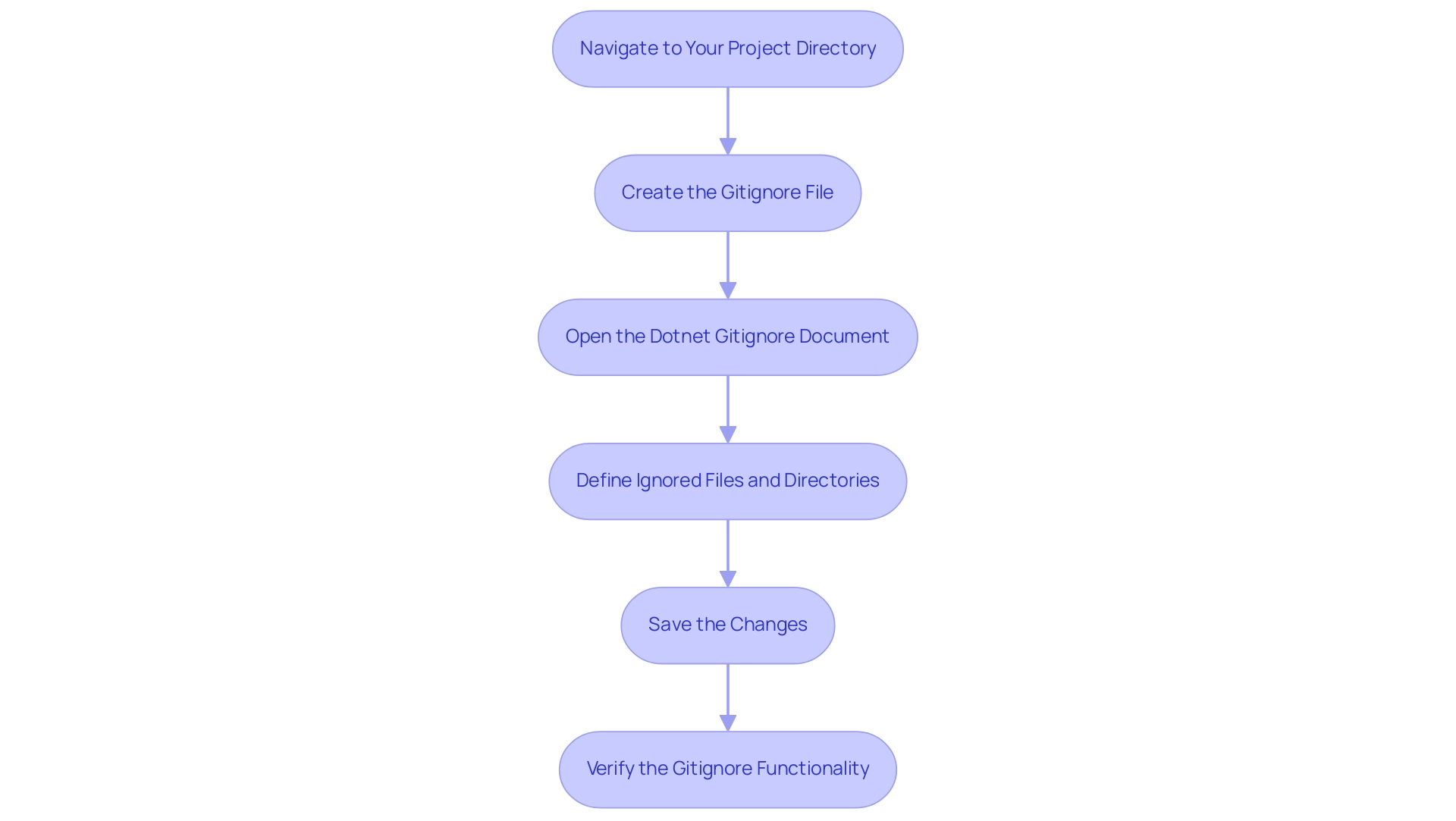
Common Mistakes to Avoid When Creating a .NET Gitignore File
When creating a dotnet gitignore list, developers frequently make several typical errors that can undermine the effectiveness of their version control. Here are some pitfalls to avoid:
-
Failing to Include All Necessary Entries: Ensure that all temporary and build documents are included in your version control exclusion list, specifically in the dotnet gitignore. Missing entries can lead to bloated repositories.
-
Not Updating the Exclusion List: As your project progresses, new items may need to be disregarded. Consistently examine and revise your dotnet gitignore to reflect modifications in your project layout.
-
Neglecting the Global Git Exclusion Settings: Besides project-specific exclusion documents, think about establishing a global dotnet gitignore file for your system to manage common items across all projects, like OS-specific items.
-
Overlooking Hidden Documents: Some tools may generate concealed entries that should also be disregarded. Consistently verify for concealed items in your project folder that might require addition to your ignore list.
By steering clear of these errors, you will guarantee that your ignore list fulfills its intended role efficiently, maintaining your repository tidy and manageable.
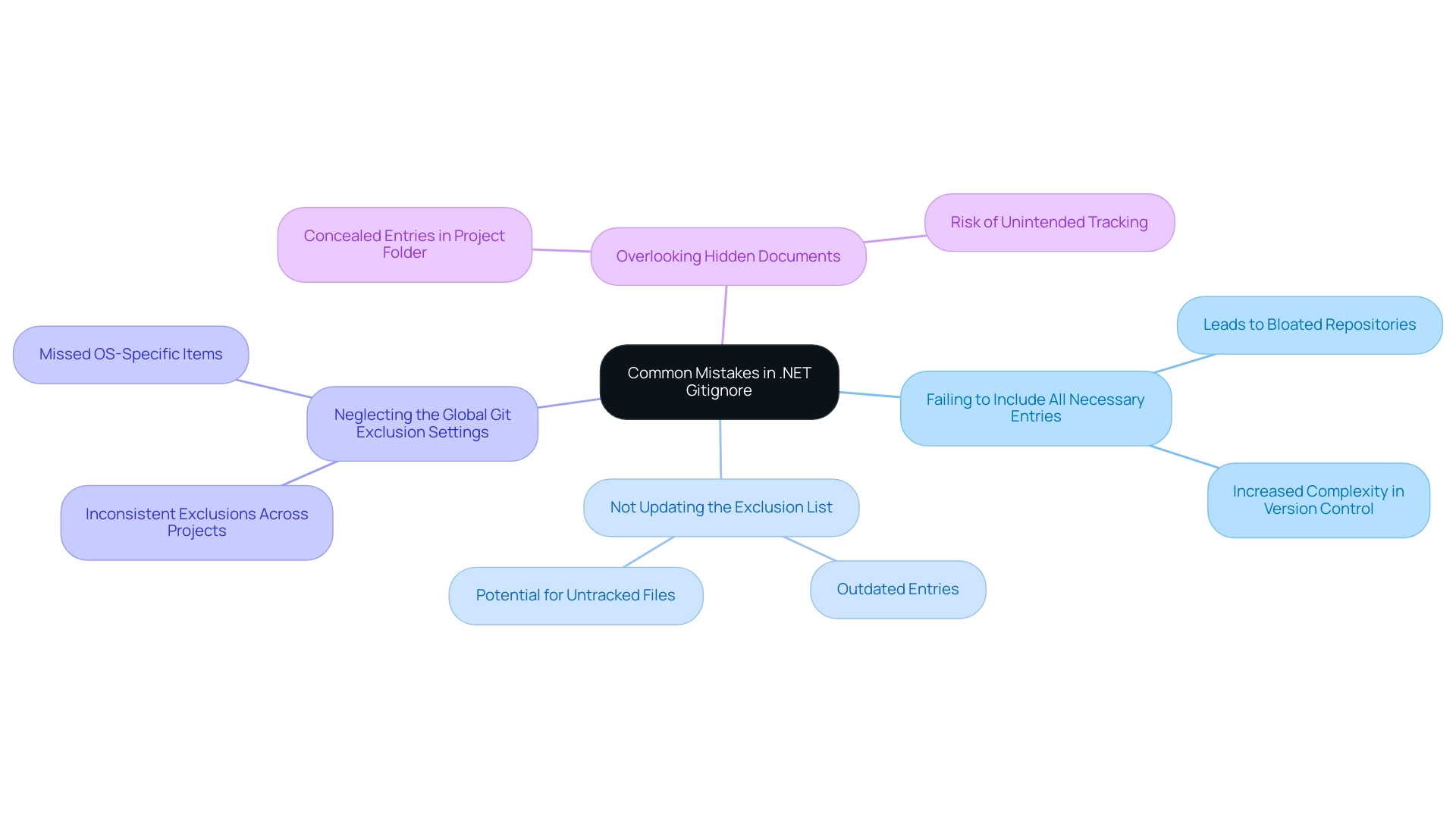
Testing Your .NET Gitignore File
After generating your .NET exclusion list, it’s essential to test its functionality to confirm that it is properly disregarding the intended documents. Follow these steps:
-
Check Ignored Files: Use the following command to verify which files are being ignored:
git check-ignore -v *This command will list files and the corresponding rules from your Gitignore file that are causing them to be ignored.
-
Stage Files for Commit: Attempt to stage files for commit using:
git add .Observe if any files that should be ignored are being staged. If they are, review your dotnet gitignore to verify the appropriate patterns are included.
-
Review Staged Changes: Run:
git statusThis will show you the current status of your working directory. Ensure that only the intended documents are staged for commit.
-
Make Adjustments: If you discover any documents that ought to be overlooked but aren't, revisit your dotnet gitignore list, include the required entries, and repeat the testing process.
By thoroughly testing your ignore list, you can confirm that your project stays organized and devoid of unnecessary clutter.
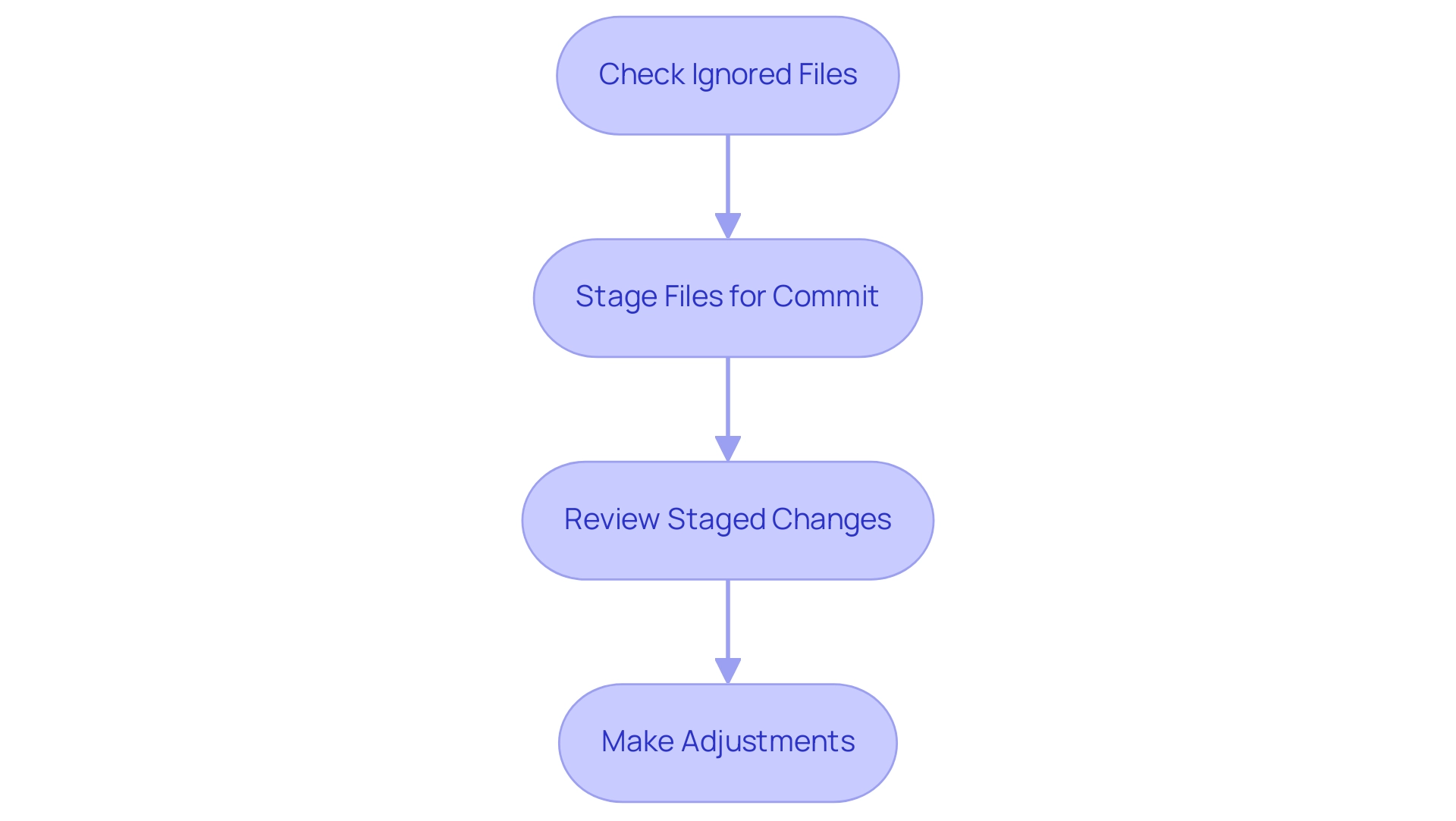
Best Practices for Maintaining a .NET Gitignore File
To make certain your .NET ignore list stays effective during the development process, consider the following best practices:
- Regularly Review and Update: Periodically examine your exclusion list to confirm it represents the current state of your project. As new documents and folders are added, modify the ignore list accordingly.
- Collaborate with Your Team: If you are working in a group, ensure that everyone is aware of the details of the ignore list. Collaborate to decide on entries that should be included to avoid conflicts.
- Document the Purpose of Entries: Consider adding remarks in your ignore list to explain why certain items or directories are excluded. This can help team members understand the rationale behind the configuration.
- Use Templates: Utilize available templates for project exclusion files on platforms like GitHub. These templates can serve as a solid foundation that you can customize to fit your specific needs.
- Test After Changes: After making any updates to your dotnet gitignore file, always test it to ensure that the correct files are being ignored and that no unintended files are included in your commits.
By following these best practices, you can maintain an effective dotnet gitignore that supports a clean and efficient development process.
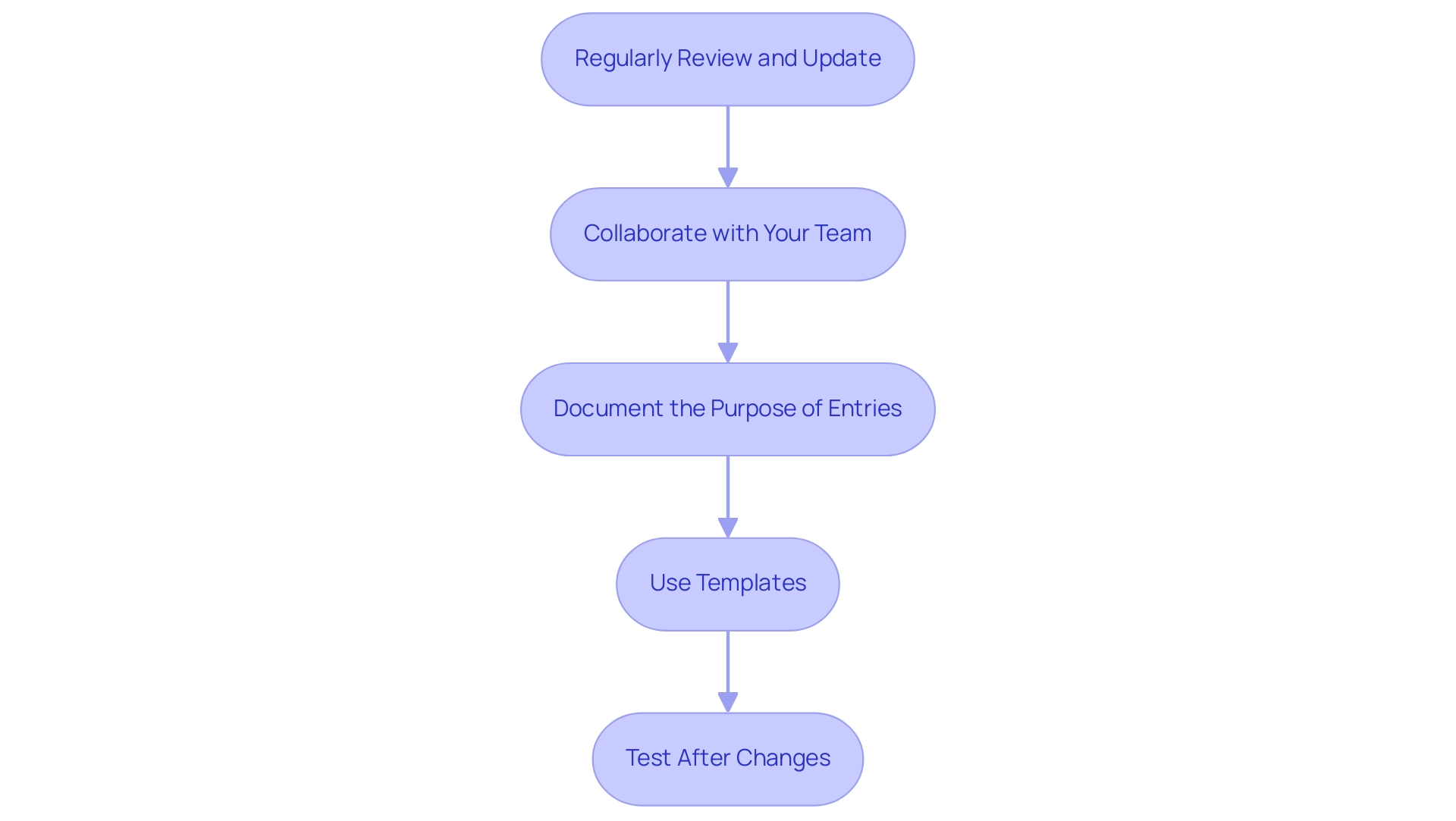
Conclusion
Utilizing a .NET Gitignore file is a fundamental practice for developers aiming to streamline their workflows and maintain an organized codebase. By understanding its purpose, creating it correctly, and avoiding common pitfalls, teams can significantly enhance their version control processes. The step-by-step guide provided ensures that even those new to .NET can confidently set up their Gitignore file, while insights into common mistakes help prevent unnecessary complications.
Regular maintenance and collaboration are key to keeping the Gitignore file effective. By reviewing and updating it as projects evolve, developers can ensure that only relevant files are tracked, thereby reducing clutter and potential conflicts. Implementing best practices such as:
- Documenting entries
- Leveraging templates
further solidifies the effectiveness of this tool.
Incorporating these strategies not only fosters a cleaner repository but also boosts overall productivity. A well-maintained .NET Gitignore file is an essential asset that allows developers to focus on what truly matters—delivering high-quality software efficiently. As the development landscape continues to evolve, prioritizing effective file management will undoubtedly yield significant benefits for teams and projects alike.
Frequently Asked Questions
What is the purpose of a Gitignore document in .NET development?
A Gitignore document is crucial for excluding items that should not be tracked by Git, such as compiled binaries, temporary data, and user-specific configurations, to maintain a clean and efficient codebase.
What are some common entries included in a .NET Gitignore file?
Common entries include: bin/ - Compiled binaries, obj/ - Intermediate object files, *.user - User-specific settings, *.suo - Solution user options, *.vs/ - Visual Studio settings.
How do you create a .NET Gitignore file?
To create a .NET Gitignore file, follow these steps: 1. Navigate to your project directory. 2. Create the Gitignore file using the command touch .gitignore or through a text editor. 3. Open the .gitignore file in a text editor. 4. Add necessary entries for items to ignore. 5. Save the changes. 6. Verify functionality with the command git check-ignore -v *.
What common mistakes should be avoided when creating a .NET Gitignore list?
Common mistakes include: 1. Failing to include all necessary entries. 2. Not updating the exclusion list as the project evolves. 3. Neglecting global Git exclusion settings for common items. 4. Overlooking hidden documents that should be ignored.
How can you test the functionality of your .NET Gitignore list?
To test the functionality: 1. Use git check-ignore -v * to check which files are ignored. 2. Attempt to stage files with git add . and observe if any ignored files are staged. 3. Run git status to review the current status of your working directory. 4. Make adjustments to your Gitignore list if necessary and retest.
What best practices should be followed to maintain an effective .NET Gitignore?
Best practices include: 1. Regularly review and update the exclusion list. 2. Collaborate with your team to ensure everyone understands the ignore list. 3. Document the purpose of entries for clarity. 4. Use templates for project exclusion files as a foundation. 5. Test the Gitignore file after making changes to ensure it functions correctly.




